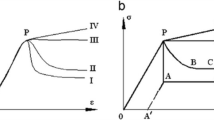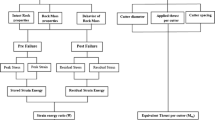Abstract
The specific energy (SE) is the most important parameter to estimate the energy consumption in tunnel boring machines (TBMs). It is defined as the amount of required energy to excavate a unit volume of rock mass which used to predict the performance of TBMs. Several models are used to estimate the SE based on different parameters such as the rock mass properties, disc cutter dimensions and cutting geometry. The aim of this work is to propose new relations between the SE and the strain energy of rock mass (W) using the geological mappings of rock mass and TBM operational parameters from Amir-Kabir Water Transferring Tunnel of Iran. W is an appropriate criterion to estimate SE because it is a function of different parameters such as rock mass behavior, pre and post failure properties and peak and residual strains. In this study, to increase the correlation coefficient of relation between the mentioned parameters, the rock mass is classified in two methods, in the first method according to the geological strength index (GSI) all data is classified in three classes such as weak, fair and good and in the second method using the drop to deformation modulus ratio (η) the classification of data is performed in three classes such as η < 0.05, 0.05 ≤ η < 10 and η ≥ 10. The results show that there are direct relations between both parameters. It is suggested to estimate SE in all rock mass classes using the proposed relations based on GSI classification.













Similar content being viewed by others
References
Acaroglu O, Ozdemir L, Asbury B (2008) A fuzzy logic model to predict specific energy requirement for TBM performance prediction. Tunn Undergr Space Technol 23:600–608
Zhang Q et al (2012) Modeling specific energy for shield machine by non-linear multiple regression method and mechanical analysis. In: Proceedings of the 2011 2nd international congress on computer applications and computational science. Springer, Berlin, pp 75–80
Alejano L, Alonso E (2005) Considerations of the dilatancy angle in rocks and rock masses. Int J Rock Mech Min Sci 42:481–507
Alejano L, Rodriguez-Dono A, Alonso E, Fdez-Manin G (2009) Ground reaction curves for tunnels excavated in different quality rock masses showing several types of post-failure behaviour. Tunn Undergr Space Technol 24:689–705
Alejano L, Alonso E, Rodriguez-Dono A, Fernandez-Manin G (2010) Application of the convergence-confinement method to tunnels in rock masses exhibiting Hoek–Brown strain-softening behaviour. Int J Rock Mech Min Sci 47:150–160
Altindag R (2003) Correlation of specific energy with rock brittleness concepts on rock cutting. J S Afr Inst Min Metall 103:163–171
Atici U, Ersoy A (2009) Correlation of specific energy of cutting saws and drilling bits with rock brittleness and destruction energy. J Mater Process Technol 209:2602–2612
Bieniawski Z, Tamames B, Fernandez J, Hernandez M (2006) Rock mass excavability (RME) indicator: new way to selecting the optimum tunnel construction method. In: ITA-AITES World Tunnel Congress & 32nd ITA General Assembly, Seoul.
Bilgin N, Copur H, Balci C (2013) Mechanical excavation in mining and civil industries. CRC Press, Boca Raton
Boyd R (1987) Performance an experimental development of the mobile miner at Mount Isa. In: Proceedings Rapid Excavation and Tunneling Conference, pp 747–768.
Cai M, Kaiser P, Uno H, Tasaka Y, Minami M (2004) Estimation of rock mass deformation modulus and strength of jointed hard rock masses using the GSI system. Int J Rock Mech Min Sci 41:3–19
Cai M, Kaiser P, Tasaka Y, Minami M (2007) Determination of residual strength parameters of jointed rock masses using the GSI system. Int J Rock Mech Min Sci 44:247–265
Dehkordi MS, Shahriar K, Maarefvand P, Gharouninik M (2011) Application of the strain energy to estimate the rock load in non-squeezing ground condition. Arch Min Sci 56:551–566
Dehkordi MS, Lazemi H, Shahriar K (2015a) Application of the strain energy ratio and the equivalent thrust per cutter to predict the penetration rate of TBM, case study: Karaj-Tehran water conveyance tunnel of Iran Arabian. J Geosci 8:4833–4842
Dehkordi MS, Lazemi H, Shahriar K, Dehkordi MS (2015b) Estimation of the rock load in non-squeezing ground condition using the post failure properties of rock mass. Geotech Geol Eng 33:1115–1128
Hoek E (1994) Strength of rock and rock masses ISRM News Journal 2:4–16
Hoek E (2000) Practical rock engineering. Course note by Evert Hoek, Rocscience.
Hoek E, Brown E (1997) Practical estimates of rock mass strength. Int J Rock Mech Min Sci 34:1165–1186
Hoek E, Diederichs MS (2006) Empirical estimation of rock mass modulus. Int J Rock Mech Min Sci 43:203–215
Hoek E, Karakas A (2008) Practical rock engineering. Environ Eng Geosci 14:55–58
Hoek E, Marinos P, Benissi M (1998) Applicability of the geological strength index (GSI) classification for very weak and sheared rock masses. The case of the Athens Schist Formation. Bull Eng Geol Environ 57:151–160
Hoek E, Carranza-Torres C, Corkum B (2002) Hoek–Brown failure criterion-2002 edition. In: Proceedings of NARMS-Tac, pp 267–273
Muirhead IR, Glossop LG (1968) Hard rock tunnelling machines. Trans Inst Min Metall 77:A1–A48.
Ramezanzadeh A, Rostami J, Kastner R (2004) Performance prediction models for hard rock tunnel boring machines. In: Proceedings of sixth Iranian tunneling conference, Tehran, Iran
Roxborough FF, Phillips HR (1975) Rock excavation by disc cutter. Int J Rock Mech Min Sci Geomech Abstr 12:361–366
Sakurai S (1993) Back analysis in rock engineering. Comprehensive rock engineering. J Excav Support Monit 4:543569
Sakurai S (1997) Lessons learned from field measurements in tunnelling. Tunn Undergr Space Technol 12:453–460
Sakurai S, Takeuchi K (1983) Back analysis of measured displacements of tunnels Rock. Mech Rock Eng 16:173–180
Sahel Consulting Engineers (SCE) (2009) Engineering geology report of Karaj–Tehran water conveyance tunnel (lot 2)
Teale R (1965) The concept of specific energy in rock drilling. Int J Rock Mech Min Sci Geomech Abstr 1:57–73
Wang L, Kang Y, Cai Z, Zhang Q, Zhao Y, Zhao H, Su P (2012) The energy method to predict disc cutter wear extent for hard rock TBMs. Tunn Undergr Space Technol 28:183–191
Wawersik WRFC (1970) A study of brittle rock fracture in laboratory compression experiments. Int J Rock Mech Min Sci Geomech Abstr 7:561–575
Acknowledgements
The authors are indebted to all staff, including consulting engineers, contractors, and employers, especially Sahel Consulting Engineers (SCE), for providing us with data, as well as all individuals who helped to us to prepare this paper.
Author information
Authors and Affiliations
Corresponding author
Rights and permissions
About this article
Cite this article
Mirahmadi, M., Tabaei, M. & Dehkordi, M.S. Estimation of the Specific Energy of TBM Using the Strain Energy of Rock Mass, Case Study: Amir-Kabir Water Transferring Tunnel of Iran. Geotech Geol Eng 35, 1991–2002 (2017). https://doi.org/10.1007/s10706-017-0222-z
Received:
Accepted:
Published:
Issue Date:
DOI: https://doi.org/10.1007/s10706-017-0222-z




